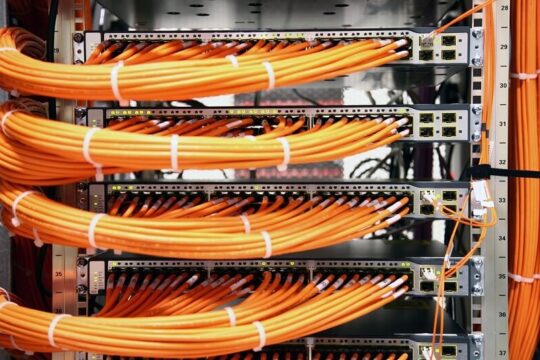- What is a core network?
- What is a regional network?
- What is an access network?
- Core network vs access network: what’s the difference?
- How does data flow between core and access networks?
- Why network architecture matters for your business
- Connectivity you trust, built for your business
At a high level, communications networks can be divided into three broad segments: core, regional and access networks. We explain how they differ and why it matters for your business’s connectivity.
What is a core network?
A core network, also known as a backbone network, transports massive data volumes over long distances at extremely high speed. It connects regional and international data centres, internet exchanges and large-scale service providers.
Core networks use technologies like optical connectivity and DWDM for long-distance, high capacity data transmission, while protocols like MPLS and BGP manage traffic and routing. The prime example of a core network is the internet backbone, which spans continents and links major global network operators.
What is a regional network?
A regional network, also known as the “middle mile”, acts as a bridge between national core networks and local access networks. It transmits data between regions and cities, connecting smaller network operators, mobile networks and large enterprise sites to each other, regional data centres or the wider internet.
Regional networks use high capacity optical fibre links and technologies like Carrier Ethernet, optical networking and IP/MPLS to manage traffic efficiently. They provide regional data centre interconnects, connect Altnet networks, and deliver backhaul for fixed and mobile networks.
What is an access network?
Also known as the “last mile”, an access network is the final stretch of a telecoms network that connects your premises to your service provider’s infrastructure. Last-mile connections typically use fibre optic, coaxial or copper cables, with 4G/5G radio, P2P microwave radio, or satellite links used in mobile networks or remote locations without fixed-line access.
With FTTP or FTTC business broadband, the last mile is typically a contended passive optical network. That means bandwidth is shared with other users, and your internet speeds may fluctuate. In contrast, most high capacity business networks use Ethernet or DIA leased lines to provide uncontended access, consistent speeds and improved reliability.
Core network vs access network: what’s the difference?
In short, core networks are high-speed backbone networks transporting data over long distances, while access networks are local, connecting end users to network service providers.
Core networks are built for speed and resilience, prioritising high capacity links and redundancy. By contrast, access networks are typically designed for coverage and cost-efficiency, often using contended infrastructure, especially in consumer networks. However, business-grade access networks use leased lines and Ethernet services to provide dedicated, uncontended connectivity with guaranteed performance.
Here’s a summary of how they differ:
Core network vs access network
| Core network | Access network | |
| Function | Provides high-speed data transmission across long distances | Connects end users to the service provider’s network |
| Geographic area | National and international – connecting cities, countries and continents | Local – connecting buildings, streets and neighbourhoods |
| Capacity | Very high to transport high aggregated data volumes | Lower, designed for individual or small group usage |
| Technology | Optical connectivity, DWDM, MPLS, BGP | FTTP/FTTC, DSL, leased lines, Ethernet, 4G/5G, P2P microwave radio |
| Topology | Often uses mesh or ring architecture for redundancy and resilience | Typically uses star or bus topology for simplicity and low cost |
| Users | Primarily serves ISPs, data centres, large enterprises and other major network operators | Links individual businesses, homes, and mobile devices, as well as Altnet networks at exchanges |
| Ownership | Often owned by large telecom companies or governments | Can be owned by ISPs, mobile network providers, or local government |
| Priorities | High capacity, low latency, reliability | Accessibility, low cost, Quality of Service (QoS) for end users |
As for the OSI model, core networks typically span the data link, network and transport layers (layers 2 to 4), using technologies like MPLS (often described as layer 2.5), IP routing and TCP/UDP protocols. On the other hand, access networks mainly operate in the physical and data link layers (1 and 2), although Dark Fibre can operate as an access network below these layers.
How does data flow between core and access networks?
Core, regional and access networks work together to connect end users to the internet, cloud platforms and business-critical services. Here’s a simplified breakdown:
- Core network: Carries large volumes of aggregated traffic over long distances, linking to national backbones, internet exchanges, cloud platforms and data centres.
- Regional network: Transports traffic across towns, cities or regions, aggregating data between access and core layers.
- Access network: Connects your premises or end-user devices to the nearest cabinet, exchange, point of presence or base station.
Core network vs regional network vs access network

Together, they provide the connectivity your business needs – linking sites, cloud services and the wider internet.
Why network architecture matters for your business
Understanding the roles of core, regional and access networks is vital when choosing the right connectivity for your business. Not all networks are created equal. Your provider’s network design and resilience determine how reliably your sites interconnect, access the internet and run the real-time applications your business relies on.
First, does your provider operate a resilient, high capacity core network built for low latency critical business applications? A robust core network is essential for site-to-site connectivity and seamless access to the internet and cloud services.
Second, does your provider offer nationwide reach and a choice of last-mile providers to deliver the best connection where you need it? This helps ensure reliable, cost-effective connectivity at every site, including remote or harder-to-reach locations.
Ultimately, you need to determine your business’s priorities – capacity, latency, resilience or reach – and ask the right questions when evaluating providers.
Connectivity you trust, built for your business
At Neos Networks, we deliver high capacity, low latency connectivity for UK businesses of all sizes. As a Critical National Infrastructure provider with the UK’s largest business-dedicated fibre network, we deliver always-on networks for organisations nationwide.
Whether you need Dedicated Internet Access, Business Ethernet, Optical Wavelengths or Dark Fibre, we’ll design a network tailored to your needs and scalable for long-term growth.
Want to explore your options?
Speak to an expert
Let’s make connectivity work for your business.





